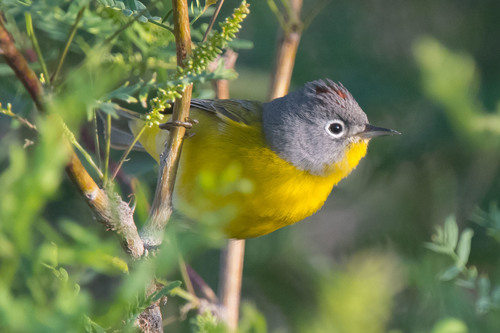
Nashville Warbler
The Nashville Warbler (Leiothlypis ruficapilla) is a small, active songbird known for its subtle beauty and energetic foraging behavior. It plays a crucial role in controlling insect populations within its forest and shrubland habitats. While not as brightly colored as some warblers, its olive-green back, gray head, and distinctive white eye-ring make it readily identifiable. This species holds a place in North American ornithological history, being named for Nashville, Tennessee, where Alexander Wilson first described it, though it is not particularly common in that area.
11-12 cm
Length
18-20 cm
Wingspan
Least Concern
Conservation Status
Distribution
The Nashville Warbler breeds across a wide swath of North America, from central Canada (British Columbia to Nova Scotia) south into the northeastern and western United States. It winters in Mexico, Central America, and southern Texas. They are known to migrate through much of the eastern and central United States.
Lifespan
Typical lifespan in the wild is unknown, but banding records suggest individuals can live at least 5 years.
Nashville Warbler's Habitat
Habitat Types
Mixed coniferous and deciduous forests, Boreal forests, Shrubby areas, Forest edges, Second-growth woodlands
Climate Zones
Temperate, Boreal
Adaptations
Their preference for edges and second-growth forests indicates an adaptation to disturbed habitats, allowing them to thrive in areas undergoing regrowth. Their agility and small size are well-suited for navigating dense foliage.
Variations
Two subspecies are generally recognized: *L. r. ruficapilla* (eastern) and *L. r. ridgwayi* (western). The western subspecies, sometimes called the Calaveras Warbler, is slightly duller in coloration.
Appearance
Breeding Plumage
Males in breeding plumage have a brighter yellow throat and more prominent chestnut crown patch (often concealed) than non-breeding males or females. Non-breeding plumage is generally duller.
Seasonal Feather Changes
Plumage is brightest during the breeding season (spring and summer) and becomes duller in the fall and winter.
Sex Based Plumage Differences
Males have a more distinct chestnut crown patch and brighter yellow throat than females, particularly during the breeding season.
Notable Features
Prominent white eye-ring, Gray head contrasting with olive-green back, Chestnut crown patch (often concealed), Thin, pointed bill
Diet and Feeding
Primary Foods
Insects, Spiders, Caterpillars, Larvae
Foraging Behavior
Nashville Warblers are active foragers, gleaning insects from leaves and twigs in the lower to middle levels of trees and shrubs. They often hover briefly to pick insects from the undersides of leaves.
Specializations
Their thin, pointed bill is well-suited for picking small insects from foliage.
Seasonal Diet Variations
Diet consists primarily of insects during the breeding season. In migration and winter, they may supplement their diet with small amounts of berries and seeds.
Behavior
Social Structure
Generally solitary or in pairs during the breeding season. May join mixed-species flocks during migration and on wintering grounds.
Communication
Simple, two-part song ('see-bit see-bit see-bit see-bit-bit-bit'), Sharp 'chip' call notes
Migration
Nashville Warblers are Neotropical migrants, traveling between breeding grounds in North America and wintering grounds in Mexico and Central America. They migrate at night.
Territorial or Group Behaviors
Males defend breeding territories through song and aggressive displays. Outside of the breeding season, they are less territorial.
Conservation
Threats
Habitat loss and fragmentation (both breeding and wintering grounds), Pesticide use (reducing insect prey), Collisions with buildings during migration
Protection Programs
Conservation of forested habitats, Efforts to reduce pesticide use, Promotion of bird-friendly building practices
Local National Laws
Protected under the Migratory Bird Treaty Act in the United States.
Population Trend
Stable
Population Estimates
The global population is estimated to be around 24 million individuals.
Interesting Facts
The Nashville Warbler was named by Alexander Wilson, who encountered the species near Nashville, Tennessee, during its migration.
However, it is not a common breeding bird in that area.
The western subspecies, *L. r. ridgwayi*, is sometimes referred to as the Calaveras Warbler.
This reflects a regional variation in appearance and genetics.
They are known for their constant tail-flicking behavior.
The reason for this behavior is not fully understood, but it may be related to foraging or communication.
Faqs about Nashville Warbler
What does a Nashville Warbler sound like?
Its song is a simple, two-part 'see-bit see-bit see-bit see-bit-bit-bit'. It also has a sharp 'chip' call note.
Where can I see a Nashville Warbler?
Look for them in mixed forests, shrubby areas, and forest edges during the breeding season in their range. They can also be seen during migration throughout much of the eastern and central United States.
Are Nashville Warblers endangered?
No, they are currently listed as Least Concern by the IUCN, with a stable population trend.
Copyright @ Nature Style Limited. All Rights Reserved.
 English
English